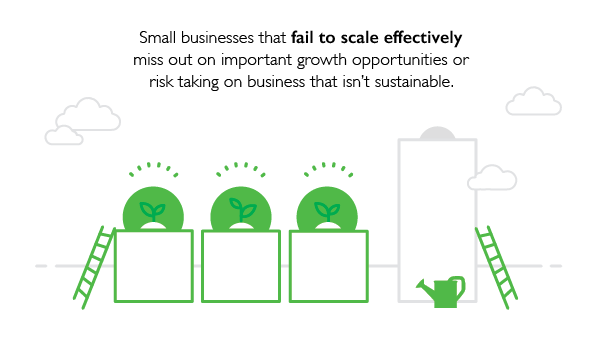Business growth is a beautiful thing. It’s a sign that your hard work and sacrifice to get a venture off the ground has paid off, and affirmation of your entrepreneurial chops. But as many small business owners contending with growth soon learn, the real challenge is scaling to improve profitability. More customers means more revenue, but it also means more resources are needed to lock down that revenue. In other words, you’re adding revenue just as quickly as expense to grow the business.
Realistically, the goal should be to scale the business. This means you’re increasing revenue faster than you’re increasing spending to sustain that new revenue. Simple, right? Well, not exactly. You may need new personnel, new equipment or even new real estate to support your growing operation. Many small businesses struggle in this key phase of their development, often leading to them missing important growth opportunities or, alternatively, biting off more than they can chew. Scaling a business is a delicate balancing act that demands careful planning. A good high-level starting point is to keep the following in mind.

Make customer loyalty a priority
We’ve all heard the tale about the little puppy on the bridge who dropped his bone into the water because he wanted the bigger reflection of it. Focusing too much on finding new business without trying to build loyalty among your existing customers is akin to that fable. It’s about five times more expensive to attract new customers than it is to nurture and upsell existing ones, according to Forbes.
Simply put, customer loyalty programs should be treated like a priority from day one of your business. This is crucial for maximizing your initial investments. The hard work that you put into creating loyalty programs—whether it’s building out a mailing list to help promote deals, events and offerings, or providing simple punch-hole cards to get every sixth meal free—will help you incentivize customers to return, and lock down recurring sources of revenue.
Every industry is different, so it’s important to strategize ways that you can encourage first-time customers to return, regardless of what stage of development your business is in. In the long run, you’ll save a lot of money on marketing and new acquisitions.
Timing is everything
Before you begin investing with the intent of scaling, it’s important that you’re actually seeing signs of growth. Observable or anecdotal evidence such as more foot traffic or replenishing inventory more often are important, but you should also be closely looking at your costs and revenues to confirm your suspicions.
According to the Startup Genome Project, 70% of startups and SMBs fail by scaling prematurely. They become a little too bullish at the first signs of success, and begin investing in more personnel and equipment. Waiting too long isn’t ideal, either, as it can lead to missed revenue opportunities and even force you to turn down deals because you lack the bandwidth.
A few tell-tale signs that your business may be ready to scale include:
- You’re business model is a proven concept, and your bottom line demonstrates that it’s fundamentally and financially sound.
- You have a stable cash flow and reliable success, meaning your best outcomes are not significantly greater than your worst.
- You have qualitative evidence of growth; for instance, you’re repeatedly surpassing monthly and quarterly goals (don’t necessarily take one strong quarter as a sign of imminent growth).
How you choose to scale is just as important as when you choose to scale. Consider the long-term ROI versus the total cost of ownership of any capital expenditures, whether it’s buying a new harvester or purchasing real estate for a second location. Where possible, try to convert CAPEX into OPEX; for example, invest in pay-as-you-go cloud services rather than attempting to manage operations that are secondary to your core value prop. In other words, the bulk of your larger investments should go toward getting even better at doing what you already do best.
An external perspective is crucial
Every business is different, so it’s hard to assess if you’re in a strong position to scale, and whether the steps you intend to take are prudent. Often, the best source of financial wisdom comes from a trusted lender.
Commercial bankers at Bank Midwest work directly with small businesses to advise them on the best types of loans based on company performance. When your business starts exhibiting signs of growth, and if you suspect it’s time to scale, a reliable small-business lender can provide some much-needed affirmation, or pushback—and when you really are ready—act as an important funding source.
